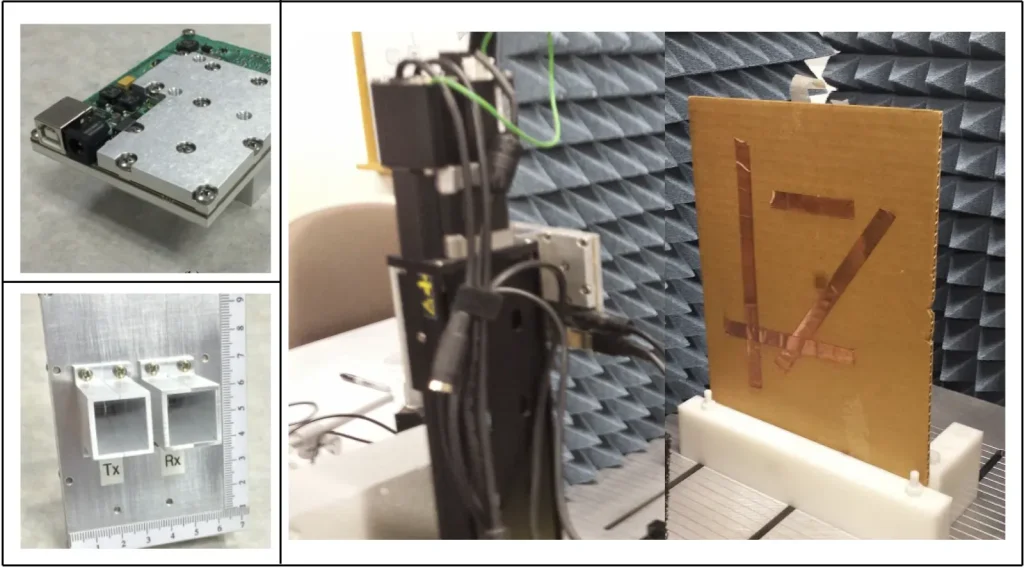The emergence of mmWave imaging technology from MIT represents a significant leap forward in robotic inspection systems, enabling unprecedented capabilities in warehouse automation. Utilizing millimeter wave signals, similar to those employed in Wi-Fi, this innovative technology can precisely detect damage within sealed packages without the need for unboxing. With its ability to create detailed 3D imaging models of the contents, mmWave imaging technology not only enhances efficiency during logistics operations but also ensures higher standards of quality control. As it permeates industries, this breakthrough could transform the landscape of damage detection, allowing for real-time assessments that bolster overall safety. By integrating this advanced imaging technology into robotic systems, warehouses could operate more effectively, setting a new standard for automation in the marketplace.
Millimeter wave imaging represents a groundbreaking advancement in the field of robotic inspection technology, facilitating enhanced monitoring capabilities in various sectors including warehouse logistics. This innovative approach employs high-frequency signals to penetrate packaging materials, allowing for internal evaluations of items without physical interference. By harnessing the power of advanced imaging techniques, such as those seen in 3D imaging technology, inspection processes can achieve remarkable accuracy and efficiency in damage detection. The implications of this MIT breakthrough extend far beyond traditional applications, paving the way for smarter automation solutions that significantly optimize operation cycles. As industries evolve, the integration of such imaging systems could redefine how businesses manage and inspect their goods, thereby improving overall productivity.
The Role of mmWave Imaging Technology in Robotic Inspection Systems
mmWave imaging technology is at the forefront of modern robotic inspection systems, enabling a revolutionary method of examining sealed packages without the need for physical unboxing. This cutting-edge technology operates using millimeter-wave frequencies, which can penetrate through materials like cardboard and plastic, capturing detailed reflections from hidden objects. As robots equipped with systems like MIT’s mmNorm navigate through warehouses, they can effectively identify damages or irregularities in packages in real time, enhancing operational efficiency and reducing the likelihood of mishandled items.
By integrating mmWave imaging technology into robotic inspection protocols, warehouses can see significant improvements in their quality control processes. Unlike traditional inspection methods that rely heavily on manual labor or destructive testing, mmWave-enabled robots can scan packages quickly and safely, delivering vital information about the content with remarkable accuracy. This innovation not only streamlines the inspection phase but also opens new avenues for automation, allowing for real-time evaluations of package integrity, which is critical in maintaining high standards in warehouse management.
Enhancing Warehouse Automation with 3D Imaging Technology
The integration of 3D imaging technology in robotic arms marks a significant advancement in warehouse automation, transforming how logistics companies operate. By utilizing sophisticated algorithms and millimeter wave sensors, robots can generate accurate 3D models of package contents without ever opening the box. This means that warehouse staff can spend less time manually checking items, leading to increased productivity and reduced operational costs. As warehouses become more automated, the ability to leverage such technology for real-time insights into package conditions is invaluable.
With the incorporation of 3D imaging technology, robotic systems can not only identify damaged goods but also capture detailed data on the orientation and shape of items within packages. This capability is crucial for predictive analytics, allowing warehouses to preemptively address issues related to product quality and shipment errors. The evolution of warehouse automation through these advanced technologies signifies a move towards a future where robots play a critical role in ensuring smooth operations and customer satisfaction.
The Importance of Damage Detection in Supply Chain Management
Damage detection plays an essential role in supply chain management, as it directly impacts product quality and customer satisfaction. The ability to identify damaged goods at the warehouse level before they reach the customers can save companies from significant losses and enhance their reputation in the market. Technologies like MIT’s mmNorm provide a non-invasive solution to this challenge, allowing for immediate assessments of package contents without disrupting the workflow of the supply chain.
Incorporating effective damage detection systems into the supply chain can lead to enhanced decision-making processes. For instance, when robots can accurately assess the condition of items in real-time, warehouse managers can make informed decisions regarding returns or replacements, improving overall efficiency. This proactive approach not only mitigates the risks associated with sending out defective products but also fosters trust and reliability in the eyes of consumers.
Exploring New Frontiers: Other Applications for mmWave Imaging
Beyond warehouse settings, mmWave imaging technology is uniquely positioned to make significant impacts in various fields. For instance, in factory production lines, robots utilizing this imaging system can perform quality checks on components quickly, ensuring that production standards are consistently met. This adaptability demonstrates the versatility of mmWave imaging technology and its potential to revolutionize not only logistics but also manufacturing processes.
Assisted-living facilities could also benefit from mmWave imaging, as it allows for safety checks of items like food parcels or medication containers without disrupting the residents’ peace. This technology enhances security measures, ensuring that residents receive safe and intact items while maintaining their comfort. The potential for mmWave imaging technology to facilitate such crucial tasks highlights its broad applicability and the positive implications it can have across different sectors.
The Impact of MIT’s Breakthrough on Industry Standards
MIT’s groundbreaking work with mmWave imaging technology sets a new standard for the automation and robotics industry. As competitors and other institutions take notice of the advancements achieved with the mmNorm system, there’s likely to be a stampede for similar developments, pushing the envelope for what robots can achieve in inspection and automation. The pursuit of high accuracy in damage detection advances the overall competency and reliability of automated systems, influencing operational standards in warehouses and other facilities.
As industries start adopting these pioneering technologies, the advantages of employing mmWave imaging could lead to significant cost savings and increased efficiency. Improved damage detection not only minimizes waste and promotes sustainability but also enhances product integrity, thereby fostering a competitive edge for companies that embrace such robotic innovations. This MIT breakthrough could very well shape the future landscape of industry standards in robotic inspection systems.
The Evolution of Robotic Systems for Real-time Assessments
The evolution of robotic systems equipped with high-precision tools enables real-time assessments of package contents, fundamentally transforming logistics and warehouse management. Robots capable of executing inspections on the fly represent the next tier in autonomous technology, where they not only perform tasks but also analyze and report findings instantaneously. This grants managers the autonomy to oversee operations without micromanaging every step, thereby optimizing resource allocation.
Furthermore, real-time data collection from these robotic inspections serves as a valuable resource for continuous improvement initiatives within the supply chain. The insights garnered can identify recurring issues, shine a light on systemic inefficiencies, and guide strategic decisions on inventory management and product distribution. With advanced robotic systems equipped for immediate damage detection, companies can pivot quickly in response to emerging trends and challenges in the marketplace.
Challenges and Limitations of mmWave Technology in Inspection Systems
While mmWave imaging technology heralds transformative changes in robotic inspection systems, it does face certain challenges and limitations. One of the key drawbacks is its effectiveness in inspecting objects shielded by metal or thicker materials. Such limitations necessitate a thorough understanding of the environments in which mmWave imaging is deployed, ensuring that robots are utilized in contexts where they can perform optimally.
This recognition enables developers and businesses to devise complementary systems that can work in tandem with mmWave imaging. For instance, integrating multiple technologies may provide a more comprehensive solution for diverse inspection needs, paving the way for more versatile applications and enhanced robotic capabilities across various industries. By addressing these challenges, the full potential of robotic inspection systems may be realized.
The Future of Robotics in Ensuring Safety Standards
As the landscape of warehouse automation evolves, the future role of robotics in ensuring safety standards becomes increasingly pivotal. With technologies like mmWave imaging, robots can perform safety checks on packages and containers, ensuring that potentially harmful items are identified and managed before they affect workers or customers. This capability aligns with the growing emphasis on safety in operational environments, transforming how risk assessments are approached within warehouses.
Moreover, as regulatory pressures around safety and quality standards tighten, the integration of robotic systems with sophisticated imaging technologies offers companies a proactive approach to compliance. Through consistent monitoring and damage detection, organizations can better adhere to safety protocols, gaining confidence not just in their internal processes, but also in the eyes of their clientele. The future will likely see even greater convergence of technology and safety practices, driven by the need for secure and trustworthy operations.
Key Takeaways from MIT’s mmWave Imaging Innovation
Through its mmWave imaging innovation, MIT has unlocked a new frontier in robotic inspection systems that promises to redefine efficiencies in warehouse operations. The potential for robots to assess contents and detect damage in packages holds immense implications for logistics, paving the way for more streamlined processes and enhanced customer satisfaction. As businesses increasingly leverage these capabilities, the expectations around package integrity and real-time assessments are likely to shift significantly.
In essence, MIT’s work points to a future where robots evolve from mere package carriers to intelligent systems capable of making informed decisions about items in real-time. This transformation indicates not only advancements in technology but also a holistic change in the operational standards of industries that depend on precise, reliable logistics. By adopting such technologies, companies enhance their adaptability and resilience in an ever-changing marketplace.
Frequently Asked Questions
What is mmWave imaging technology and how does it improve robotic inspection systems?
mmWave imaging technology utilizes millimeter waves to penetrate packaging materials, allowing robotic inspection systems to detect damage or anomalies inside sealed boxes without opening them. This capability enhances efficiency and accuracy in warehouse automation by enabling robots to generate 3D models of objects inside packages, ensuring quality control.
How does MIT’s mmNorm system utilize mmWave imaging technology for damage detection?
MIT’s mmNorm system employs mmWave imaging technology to detect damage within sealed containers by analyzing how signals bounce back from surfaces inside. With a focus on accurately estimating surface normals, mmNorm significantly improves 3D imaging technology’s ability to reconstruct complex items, making it a revolutionary tool for damage detection during robotic inspections.
What are the advantages of using mmWave imaging technology in warehouse automation?
The use of mmWave imaging technology in warehouse automation allows for non-invasive damage detection inside packages, reducing the need for manual inspections. This results in increased efficiency, lower operational costs, and enhanced accuracy in identifying issues with products, ultimately streamlining logistics and improving the supply chain process.
In what ways does mmWave imaging technology impact 3D imaging technology?
mmWave imaging technology enhances 3D imaging technology by providing high-resolution images of hidden surfaces within sealed objects. By capturing intricate details through the reflection of millimeter waves, it allows for a more accurate understanding of object shapes and orientations, which is particularly beneficial for applications in robotic inspection systems.
What breakthroughs in mmWave imaging technology have emerged from MIT?
MIT has developed the mmNorm system, a breakthrough in mmWave imaging technology that allows robots to accurately detect contents and potential damage inside sealed boxes. This advancement represents a significant leap in efficiency and accuracy for damage detection in automated systems, illustrating the immense potential of this technology across various industries.
How might mmWave imaging technology be applied beyond warehouse automation?
Beyond warehouse automation, mmWave imaging technology can be applied in various fields such as factory inspection for quality control, security screening to detect threats within packages, and even in healthcare settings to monitor contents in assisted-living facilities without disturbing residents, showcasing its versatility in damage detection.
What limitations does mmWave imaging technology face in damage detection?
While mmWave imaging technology offers significant benefits, it has limitations when detecting objects concealed behind metal or very dense materials. These barriers can hinder the penetration of millimeter waves, potentially reducing the system’s effectiveness in certain application contexts.
How does mmWave imaging technology compare to traditional imaging technologies in terms of damage detection?
mmWave imaging technology outperforms traditional imaging technologies by providing better penetration of materials and higher accuracy in identifying surface details. In robotic inspection systems, it enables real-time assessments of package conditions without the need to physically open them, increasing operational efficiency and reducing the risk of error.
What role does machine learning play in enhancing mmWave imaging technology for damage detection?
Machine learning algorithms play a crucial role in enhancing mmWave imaging technology by analyzing the complex data obtained from radar signals. By improving the algorithms used in systems like mmNorm, machine learning enables more accurate modeling of hidden objects, resulting in improved damage detection capabilities and overall system performance.
| Key Point | Details |
|---|---|
| Technology Overview | MIT’s mmWave imaging technology allows robots to identify hidden damages inside sealed boxes. |
| mmWave Imaging | Utilizes millimeter wave signals to create accurate 3D models by analyzing signal reflections. |
| Detection Capabilities | Achieved 96% accuracy in reconstructing items like power drills, surpassing previous 78% accuracy. |
| Applications | Potential uses in warehouses, production lines, and assisted living for inspections without opening packages. |
| Future Improvements | Research team aims to enhance resolution and performance with less reflective surfaces. |
Summary
mmWave imaging technology is set to revolutionize how we perceive and manage package contents without the need for unsealing. By leveraging millimeter wave signals, this innovative system enables robots to accurately detect damages and assess the integrity of items inside sealed boxes. As demonstrated by MIT’s groundbreaking mmNorm system, the potential for increased efficiency in warehouses, manufacturing, and safety in residential settings marks a significant advancement in automation and security.



